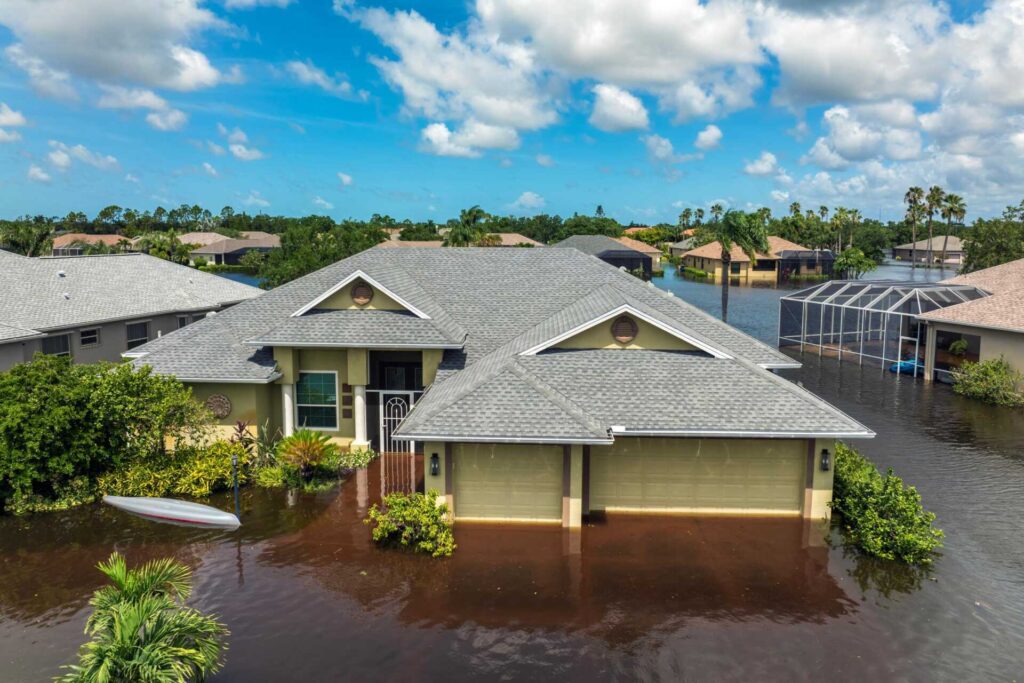
Contents
After a heavy storm, your basement floods, leaving you with standing water and damaged belongings. It’s vital to follow a systematic approach for effective flood cleanup. Start by evaluating the damage and ensuring your safety before moving on to water removal. Understanding these essential techniques can greatly impact the outcome of your recovery efforts. Are you prepared for the next steps in safeguarding your home?
Key Takeaways
- Conduct a thorough inspection of the property to assess damage, ensuring safety with proper protective gear before entering affected areas.
- Use pumps or wet vacuums to remove standing water quickly and prevent mold growth, monitoring humidity levels during the drying process.
- Clean and disinfect surfaces with EPA-approved products to eliminate contaminants, allowing proper contact time for effectiveness.
- Evaluate structural integrity by checking beams, walls, and flooring for damage, and consulting a structural engineer if necessary for extensive issues.
- Assess drainage systems and landscape grading to ensure proper water flow away from the home, preventing future flooding risks.
Assessing the Damage
How can you effectively assess the damage after a flood? Start with a thorough visual inspection of your property. Look for obvious indicators like water stains, mold growth, and structural integrity issues.
Pay close attention to walls, floors, and ceilings, noting any warping or sagging. Document your findings with photographs for insurance purposes.
Next, check your electrical systems. If water’s penetrated outlets or wiring, it poses a serious hazard. You may need a professional assessment for this aspect.
After that, inspect appliances and furniture—some items may be salvageable, while others could be deemed irreparable.
Finally, compile an extensive damage assessment report detailing all affected areas and items. This structured approach will help you understand the extent of the damage and facilitate the recovery process.
Ensuring Safety First
Before you begin any cleanup efforts, ensuring safety is paramount, especially since floodwaters can introduce numerous hazards.
First, equip yourself with appropriate safety gear, including rubber boots, gloves, and masks, to protect against contaminants. Check for structural damage before entering your home; look for sagging ceilings or unstable walls that could pose risks.
Always have your emergency contacts readily available; you may need to reach out to professionals for assistance or report hazardous situations. If the floodwaters are still present, avoid wading through them, as they can carry sharp objects and hidden dangers.
Disconnect electrical appliances and avoid using outlets in wet areas to prevent electrocution. Keep a first aid kit on hand in case of injuries.
Removing Standing Water
Before you start removing standing water, ensure you’ve taken all necessary safety precautions, such as turning off electricity and wearing protective gear.
Once you’ve secured the area, use effective water removal methods, like pumps or wet vacuums, to extract the water efficiently.
Timely action is essential to prevent further damage and mold growth.
Safety Precautions First
While the sight of standing water in your home can be overwhelming, taking the right safety precautions is crucial before you start the removal process.
First, confirm your emergency kit is accessible, containing essentials like gloves, masks, and a flashlight.
Next, prioritize electrical safety; turn off your home’s power to avoid shock hazards.
Keep these precautions in mind:
- Assess the water depth and its possible contaminants.
- Wear waterproof boots and protective gear.
- Avoid wading through the water without securing your safety first.
- Use a pump or wet/dry vacuum only if it’s safe.
Effective Water Removal Methods
Once you’ve confirmed your safety, it’s time to tackle the standing water effectively.
Start by evaluating the volume of water; for minor amounts, a wet/dry vacuum might suffice. For larger volumes, you’ll need a submersible pump. When selecting a pump, consider factors like the required flow rate and the depth of the water. Aim for a pump with a float switch for automatic operation.
Employ water extraction techniques such as siphoning to remove water from hard-to-reach areas. Be cautious of electrical hazards and confirm the power is off before using any equipment.
After extraction, thoroughly dry the area to prevent mold growth. Following these steps will help you efficiently remove standing water and mitigate further damage.
Drying Out Affected Areas
Once you’ve removed the standing water, focus on extracting any excess moisture from the affected areas.
Use dehumidifiers strategically to enhance evaporation and create a drier environment, placing them in the most saturated spots.
Regularly monitor humidity levels to ensure effective drying and prevent mold growth.
Remove Excess Water
After a flood, effectively removing excess water is essential to preventing long-term damage to your home. Start with water extraction using a submersible pump or wet/dry vacuum. Confirm proper pump operation by following the manufacturer’s instructions to maximize efficiency.
Next, focus on these key steps:
Identify areas: Locate the most affected rooms and prioritize them.
Use pumps: Deploy pumps in flooded zones to quickly remove large volumes of water.
Check for hidden water: Inspect under carpets and behind walls, as moisture can linger.
Monitor water levels: Continuously assess the effectiveness of your extraction efforts to confirm no water remains.
Use Dehumidifiers Effectively
Dehumidifiers play an essential role in drying out areas affected by flooding, helping to prevent mold growth and structural damage.
To maximize their effectiveness, focus on proper dehumidifier placement. Position the unit in the center of the affected area, ensuring it’s not obstructed by furniture or walls. This allows for ideal airflow and moisture extraction.
Set the dehumidifier to ideal settings; typically, a humidity level of around 30-60% is ideal for drying. Regularly check the water reservoir and empty it as needed to maintain continuous operation.
If possible, use multiple units in larger spaces or areas with severe saturation. Monitoring progress with a hygrometer can also help you determine when conditions are dry enough to proceed with repairs.
Cleaning and Disinfecting Surfaces
Cleaning and disinfecting surfaces after a flood is essential to prevent mold growth and the spread of bacteria. You need to follow effective surface sanitization techniques to ensure your home is safe.
Start by removing any standing water and debris. Then, use appropriate disinfectant product options that are proven to eliminate pathogens.
Consider these key steps:
Wear protective gear: Gloves, masks, and goggles are vital for your safety.
Clean surfaces: Use soap and water to remove dirt and contaminants before disinfecting.
Apply disinfectants: Choose EPA-approved products for effectiveness and follow the manufacturer’s instructions for dilution.
Allow proper contact time: Let disinfectants sit on surfaces for the recommended time to ensure maximum efficacy.
Salvaging Personal Belongings
Once you’ve secured that your surfaces are clean and disinfected, it’s time to assess the condition of your personal belongings.
Begin by categorizing items into three groups: salvageable, questionable, and unsalvageable. For salvageable items, prioritize personal item preservation. Thoroughly clean and dry each piece, using appropriate methods for materials—wood, fabric, or metal may require different techniques.
For items with sentimental value, conduct a sentimental value assessment. Consider the emotional significance versus the cost of restoration. Photograph items before attempting repairs, as this can aid in insurance claims.
For questionable items, consult professionals, especially for antiques or documents.
Lastly, discard unsalvageable items responsibly. This systematic approach ensures you retain what matters most while maintaining a clean and safe environment in your home.
Addressing Mold Growth
Although mold can begin to grow within 24 to 48 hours after a flood, addressing it promptly can greatly reduce health risks and property damage.
To effectively tackle mold growth, you need to identify the various mold types, like black mold or Aspergillus, and implement robust prevention methods.
Here are key steps to follow:
- Assess the affected area: Check for visible mold and moisture sources.
- Use protective gear: Wear gloves, goggles, and a mask to avoid inhaling spores.
- Clean and disinfect: Use a mixture of water and detergent for hard surfaces; consider specialized mold removers for stubborn areas.
- Control humidity levels: Utilize dehumidifiers and ensure proper ventilation to inhibit future growth.
Prompt action mitigates damage and creates a safer living environment, ensuring your home remains mold-free.
Repairing Structural Damage
After addressing mold growth, it’s essential to turn your attention to repairing structural damage caused by flooding.
Begin by evaluating the extent of the damage; check beams, walls, and flooring for signs of weakness. Ensuring the structural integrity of your home is paramount. Use repair techniques like reinforcing compromised beams with steel brackets or replacing damaged studs.
For warped flooring, consider removal and replacement, ensuring you choose water-resistant materials for longevity.
Next, inspect the foundation for cracks or erosion. Use epoxy injections to seal minor cracks and prevent further water intrusion. If the damage is extensive, consult a structural engineer to evaluate the need for more thorough repairs.
Preventing Future Flooding
To effectively prevent future flooding, you must first assess and modify your property’s drainage systems.
Start by evaluating how water flows around your home and ensure that it directs away from structures. Make necessary adjustments to your landscape grading to promote better runoff.
Here are some essential steps to take into account:
Inspect gutters and downspouts: Clear debris and ensure they direct water away from the foundation.
Improve landscape grading: Grade the surrounding soil to slope away from your home, reducing pooling.
Install drainage systems: Think about French drains or dry wells to redirect excess water.
Maintain vegetation: Use native plants to absorb water and stabilize soil, preventing erosion.
Summary
In flood cleanup, remember, “an ounce of prevention is worth a pound of cure.” By following these essential techniques, you restore your home and safeguard it against future disasters. Prioritize safety, address mold growth promptly, and keep your property’s integrity intact through diligent repairs. Taking these steps ensures you’re better prepared for any challenges ahead, helping you create a safer living environment for you and your family. Your proactive approach today protects your peace of mind tomorrow.
Recent Posts
Master Flood Recovery: Test Your Water Removal Skills
Many people underestimate the complexity of flood recovery, often thinking it’s just about removing water.
Why Is Emergency Water Removal Crucial After Flooding?
When flooding occurs, emergency water removal is vital to mitigate serious health risks and property
Quick Tips for Post-Flood Water Removal
After a flood, knowing how to act quickly can make a big difference. You need
